23.9
km / 14.9
miles
-
(22
minutes)
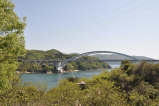
Min/Max Time :
5 / 10
Minutes
MapCode :
154 172 452*50
Description :
The Omishima Bridge crosses Hanaguri Seto between Omishima Island and Hakata Island. This bridge is the only arch bridge crossing the Seto Inland Sea. This Bridge was the first bridge completed as part of the Honshu-Shikoku Bridges project.
The arch length of the bridge was the longest one in Japan at that time. The color, light gray, of painting, materials and construction method of pavement, etc. of the Bridge were applied for other bridges in the Honshu-Shikoku Bridges.
i>Courtesy of Honshu-Shikoku Bridge Expressway Company Ltd.
The arch length of the bridge was the longest one in Japan at that time. The color, light gray, of painting, materials and construction method of pavement, etc. of the Bridge were applied for other bridges in the Honshu-Shikoku Bridges.
i>Courtesy of Honshu-Shikoku Bridge Expressway Company Ltd.
Hours :
Open daily 24/7
Address :
Hakatacho Ikata, Imabari, Ehime 794-2303
3.4
km / 2.1
miles
-
(5
minutes)

Min/Max Time :
10 / 20
Minutes
MapCode :
154 114 820*37
Phone :
089-772-3300
Website :
Hours :
Monday-Friday 10:00 – 16:00; Saturday-Sunday 09:00 – 17:00
Address :
1668-1 Hakatachō Kanoura, Imabari, Ehime 794-2302, Japan
0.6
km / 0.4
miles
-
(2
minutes)
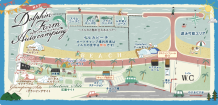
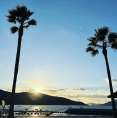
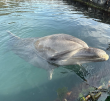


Min/Max Time :
10 / 60
Minutes
MapCode :
154 114 612*13
Phone :
089-772-8787
Website :
Hours :
Open daily 09:00 – 17:00
Address :
1673 Hakata-chō, Kanoura, Imabari, Ehime 794-2302
2.8
km / 1.7
miles
-
(3
minutes)
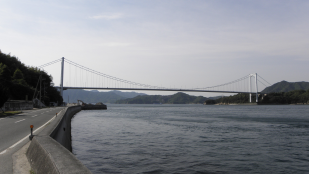
Min/Max Time :
5 / 10
Minutes
MapCode :
154 084 630*17
Description :
The Hakata–Ōshima Bridge is a Japanese suspension bridge, part of the 59 km / 37 mi Nishiseto Expressway connecting the islands of Honshū and Shikoku. Completed in 1988, it has a main span of 560 m / 1,837 ft and connects Hakatajima with Ōshima.
Courtesy of Wikipedia
Courtesy of Wikipedia
Hours :
Open daily 24/7
Address :
Miyakubocho Miyakubo, Imabari, Ehime 794-2203
5.2
km / 3.3
miles
-
(8
minutes)
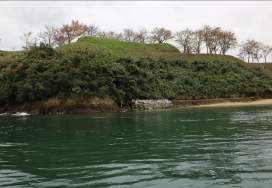
Min/Max Time :
5 / 10
Minutes
MapCode :
154 054 316*82
Description :
Viewpoint for Noshima Castle Ruins, a Sengoku period Japanese castle in Ehime Prefecture. It was the stronghold of the Noshima Murakami, a maritime clan of sailors and sometimes pirates or mercenaries. The ruins of Noshima Castle were designated as a National Historic Site in 1953
Courtesy of Wikipedia
Courtesy of Wikipedia
Hours :
Open daily 24/7
Address :
Miyakubocho Miyakubo, Imabari, Ehime 794-2203
2.0
km / 1.3
miles
-
(4
minutes)





Min/Max Time :
10 / 30
Minutes
MapCode :
381 280 804*11
Phone :
089-774-1065
Hours :
Open daily 09:00M – 17:00, closed Mondays
Address :
1285 Miyakubochō Miyakubo, Imabari, Ehime 794-2203
12.1
km / 7.5
miles
-
(20
minutes)
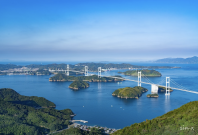

Min/Max Time :
5 / 10
Minutes
MapCode :
381 124 009*76
Phone :
089-784-2111
Description :
The observation building and deck of the Kirosan Panorama Park was designed by world-famous architect Kengo Kuma. It is located 308 m/1,010 ft above sea level and provides spectacular views of the Seto Inland Sea, and the Kurushima-Kaikyo Bridge, the longest bridge on the Shimanami Kaido.
Hours :
Open daily 24/7
Address :
487番地4 Yoshiumichō Minamiura, Imabari, Ehime 794-2115
5.2
km / 3.2
miles
-
(10
minutes)

Min/Max Time :
10 / 20
Minutes
MapCode :
381 122 838*75
Phone :
089-784-3710
Website :
Description :
Recommended for seafood barbecue.
Hours :
Open daily 10:00 – 16:00
Address :
4520-2 Yoshiumichōmyō, Imabari, Ehime 794-2114
5.3
km / 3.3
miles
-
(7
minutes)

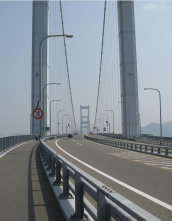
Min/Max Time :
10 / 30
Minutes
MapCode :
381 120 067*22
Phone :
078-291-1033
Description :
The Kurushima Strait Bridge is actually made up of three sections of suspension bridges, connecting several smaller islands connecting the various islands between Shikoku and Honshu. It is the world's longest series of suspension bridges.
Courtesy of Wikipedia
Courtesy of Wikipedia
Hours :
Open daily 24/7
Address :
Umashima, Imabari, Ehime 799-2123
7.2
km / 4.5
miles
-
(9
minutes)
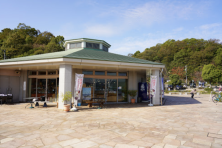
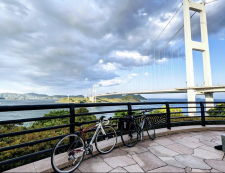
MapCode :
356 417 286*68
Phone :
089-841-5002
Website :
Description :
The Kurushima Strait Observatory not only provides fantastic views of the Kurushima Strait and the 3 Kurushima Strait Bridges, but it provides a nice rest top for an ice cream or other snack as well as other shopping needs.
Hours :
Open daily 09:00 – 18:00
Address :
2 Chome-5 Kouracho, Imabari, Ehime 799-2111, Japan
7.3
km / 4.5
miles
-
(14
minutes)



Min/Max Time :
10 / 60
Minutes
MapCode :
119 811 279*81
Phone :
089-831-9233
Description :
The Imabari Castle is well known as one of the three Mizu-jiro, or "Castles on the sea", in Japan, along with Takamatsu Castle in Kagawa Prefecture and Nakatsu Castle in Ōita Prefecture. It was the largest sea castle in Japan with a strong Funairi (port) around the Mie moat. Even now, the moat and stone wall in the center of the castle are almost completely left, and the restored castle tower, turret, and castle gate are still beautiful. The inside of the building is a museum, and you can enjoy a magnificent view of the Seto Inland Sea from the observatory on the top floor of the castle tower. The huge moat where seawater goes in and out and fish migrate is also a highlight.
Courtesy of Wikipedia
Courtesy of Wikipedia
Hours :
Open daily 09:00 – 17:00
Address :
3 Chome-1 Toricho, Imabari, Ehime 794-0036